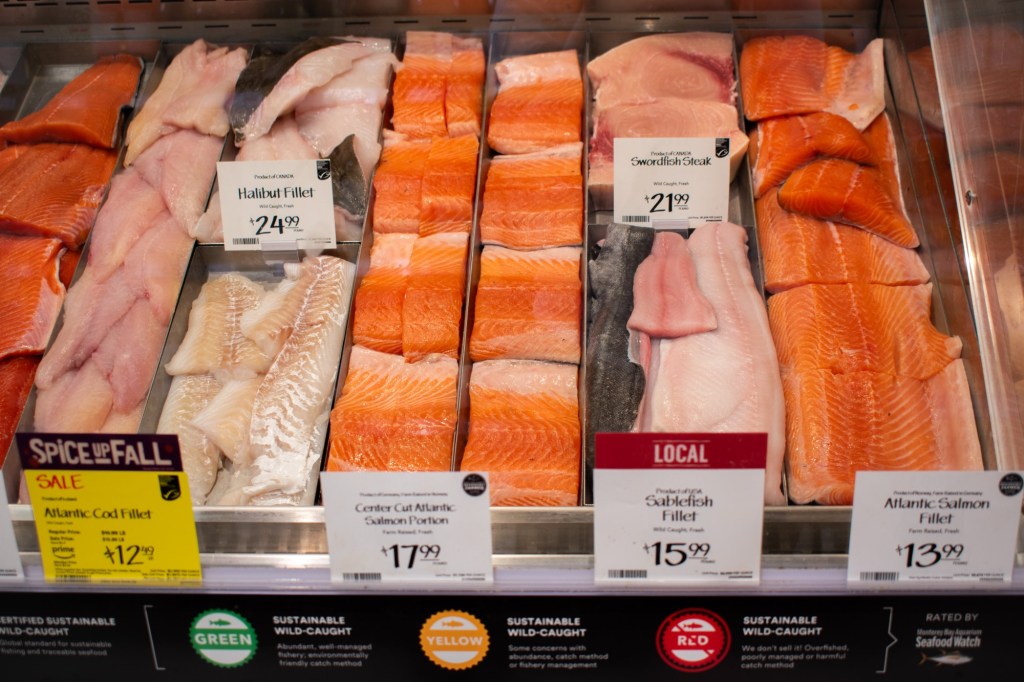MONTEREY – In the past few years, “sustainable” has become somewhat of a buzzword, with companies around the world scrambling to brand their products in a way that will make them appealing to eco-conscious customers.
Making sure these companies actually live up to their claims of sustainability has only become more important, especially when it comes to seafood. Since the 1970s, the amount of fish stocks that were at sustainable levels has dropped from 90% to 66%, and 90% of these fish stocks are being fished at or above their sustainable limit.
To the staff of the Monterey Bay Aquarium, it was a no-brainer to do something to address this issue. In the nearly 40 years since the aquarium opened its doors, its impact has expanded far beyond the boundaries of the building. One of its farthest-reaching programs is Seafood Watch, a sustainable seafood advisory list that provides guides for everyone from people shopping at the grocery store, to restaurants, to large food companies such as Whole Foods.
It “is really considered the global gold standard for science-based seafood sustainability,” Julie Packard, the executive director of the Monterey Bay Aquarium, told the Herald recently.

With the help of Seafood Watch and others, over 80% of grocery businesses in the United States and the European Union have committed to sourcing sustainable seafood. But the program wasn’t always the national scale phenomenon it is now. In fact, its foundation was something of an accident, said Erin Hudson, the Seafood Watch program director at the aquarium. In 1997, the aquarium opened up a temporary exhibit on sustainable seafood, titled “Fishing for Solutions: what’s the catch?” and focused on concepts of overfishing and bycatch.
To match the theme of the exhibit, the aquarium’s cafe modified its menu to feature more sustainably sourced seafood, and placed informative cards on each of the cafe tables to explain the changes. Aquarium staff noticed that people were taking these cards home and realized that there was a demand for information on sustainable seafood.
“That was kind of the light bulb moment, and the Seafood Watch program was born,” Hudson said.
RELATED: Going against the current: What separates Monterey from other aquariums
Seafood Watch’s guides divide fish into three different categories: green-rated, which are the most sustainable options, yellow, which are good alternatives if no green-rated seafood is available, and red, which should be avoided. The guide can be found online at https://www.seafoodwatch.org/
These recommendations are all based on scientific studies and surveys, and the ratings can vary even within fish species depending on how and where the fish was harvested. Chinook salmon, for example, are a good buy if they were farmed in New Zealand, but not so good if they were caught in Puget Sound.
At Seafood Watch’s outset in 1999, they developed one small card featuring a handful of species. But as demand grew, the amount of species grew from 32 in 2002 to over 300 species as of this year. In addition to printed cards, they also have a website and an app, where you can find guides by species or region, as well as for more specific food types such as sushi. For people on a last minute run to the grocery store, the simple regional guides should do the trick, says Hudson. But for those who want to dig deep, there is extensive information on each of the 300 species.
Although the program started out as a user-friendly production for individuals, a big part of its impact has been through the restaurant industry. “Culinarians are ambassadors for sustainable seafood,” Hudson explains. “They reach people in a very unique way through food.”
Seafood Watch partners with both restaurant behemoths like the Cheesecake Factory and individual chefs at smaller establishments. However, making seafood sustainable can be more difficult than just following a guide.
At the cafe that started it all, Monterey Bay Aquarium Executive Chef Matt Beaudin says he never has a dull day of work. One day he might be working with purveyors at U.S. Foods, the next talking to an abalone diver in San Diego. Part of the challenge of his job, he explains, is finding seafood that is both sustainable and tasty. “A lot of the time as a chef, I find that sure, it’s green rated, but it doesn’t always translate to good flavor on the plate.”
Beaudin remembers tasting the perfect green-rated Chinook salmon and wanting to buy it for the cafe, but his seafood purveyor didn’t sell it. After some convincing, however, the purveyor began selling this salmon, and now it is the go-to at restaurants all across the Monterey Bay area. “If doing the right thing is easy, everyone will do the right thing,” he explains.
But sourcing sustainable seafood hasn’t been easy for everyone. Hajime Sato, the James Beard award-winning chef and owner of Sozai, a sushi restaurant in Detroit, Michigan, decided to implement sustainable seafood in his restaurant more than 15 years ago, when questions from students in his classes prompted him to research the sourcing of common sushi fish. More than a decade later, he still struggles every day to make sure his restaurant is both sustainable and profitable. Part of the issue is distribution. According to Sato, one company distributes ingredients for nearly 80% of all sushi restaurants in the U.S. and they often don’t offer the fish Sato wants to buy. This is because consumers are used to certain types of sushi, he says, which usually use fish that aren’t sustainable.
“When people go to a sushi restaurant, they know exactly what they want to get, and if we don’t have it, then they’re going to leave,” Sato explained.


















































